ARTIGO ARTICLE
| Ewa L. Gregoraszczuk 1 | Dioxin exposure and porcine reproductive hormonal activity
Exposição à dioxina e atividade hormonal reprodutiva porcina
|
| 1 Laboratory of Reproductive Physiology and Toxicology of Domestic Animals, Department of Animal Physiology, Institute of Zoology, Jagiellonian University. Ingardena 6, 30-060 Kraków, Poland. greg@zuk.iz.uj.edu.pl | Abstract To characterize the action of 2,3,7,8-tetrachlorodibenzo-p-dioxin (TCDD) during both the follicular and luteal phases of the ovarian cycle, the direct effect of TCDD was investigated in vitro using a system of primary monolayer cell culture. Granulosa and theca cells were collected from the preovulatory follicles and cultured as a co-culture, thus resembling follicles in vivo. Luteal cells were isolated from the corpora lutea collected during the midluteal phase. In both cases cells were isolated from the ovaries of animals exhibiting natural estrus cycle. Results of these experiments suggest that TCDD decreases estradiol secretion by follicular cells and progesterone secretion by luteal cells in a dose-dependent manner. It was also shown that TCDD disrupts steroidogenesis through its influence on the activity of enzymes involved in the steroid biosynthesis cascade. In luteal cells, its action is mediated via the aryl hydrocarbon receptor (AhR) and is probably independent of estrogen receptor (ER) stimulation. Endocrine disruptors that interfere with estradiol production in the follicles can act as ovulatory disruptors, and while interfering with progesterone production by luteal cells they can act as abortifacients. Key words Dioxins; Hormones; Endocrine Disruptors
Resumo Para caracterizar a ação da 2,3,7,8-tetraclorodibenzo-p-dioxina (TCDD) durante as fases folicular e lútea do ciclo ovariano, o efeito direto da TCDD foi investigado in vitro, utilizando um sistema de cultura celular primária de camada única. Células da granulosa e teca foram coletadas a partir de folículos pré-ovulatórios e cultivadas de forma combinada, simulando folículos in vivo. As células lúteas foram isoladas do corpo lúteo durante a fase lútea média. Em ambos casos as células foram isoladas dos ovários de animais que exibiam um ciclo natural do estro. Os resultados sugerem que a TCDD diminui, de maneira dose-dependente, a secreção de estradiol pelas células foliculares e de progesterona pelas células lúteas. Foi demonstrado que a TCDD altera a esteroidogênese através da sua influência sobre a atividade enzimática envolvida na cascata de biossíntese de esteróides. Nas células lúteas, a ação da TCDD é mediada via o receptor de hidrocarboneto aromático (AhR), provavelmente de maneira independente da estimulação dos receptores de estrogênio (ER). Os disruptores endócrinos que interferem com a produção folicular de estradiol podem agir como disruptores ovarianos; ao interferir com a produção de progesterona pelas células lúteas, podem agir como abortivos. |
Introduction
Extensive research over the past decade has identified a rapidly growing list of environmental contaminants that disrupt reproductive processes in vertebrates primarily by exerting estrogenic or antiestrogenic actions (Jobling et al., 1995; McLachlan, 1993). Most of these estrogenic xenobiotics are considered to exert their estrogenic effects primarily by binding to nuclear estrogen receptors (Gray et al., 1996; Tomas & Khan, 1997). Endocrine disruptors include industrial chemicals like pesticides, polychlorinated biphenyls (PCBs), dioxin, and other synthetic chemicals. Organochlorine industrial chemicals have been extensively used in the production of plastics, flame retardants, pesticides, drugs, and a host of other commercial products. The most biologically active congener is 2,3,7,8-tetrachlorodibenzo-p-dioxin (TCDD) (Figure 1), for which the largest data base exists. TCDD is on the General Accounting Office (GAO) list of 20 reproductive and developmental toxicants, and the effects of chronic exposure to TCDD on reproduction in rodents have been well documented.
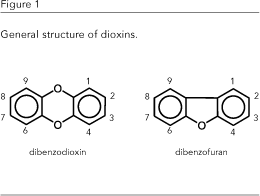
TCDD and related compounds elicit a diverse spectrum of toxic responses. Concern has increased that widespread adverse effects are occurring in humans, domestic animals, and wildlife populations as a result of exposure to environmental chemicals that possess endocrine-disrupting activity (Colborn et al., 1993, 1996).
From animal studies, TCDD was postulated to exhibit a very wide organotropy, including skin, liver, endocrine organs, and the immune system, in addition to effects on reproduction and development and increased tumor incidence. The biological and toxic effects of TCDD have been studied extensively for more than 20 years. Growing evidence suggests that the reproductive system is one of the most sensitive targets for the adverse effects of these compounds (Gray Jr. & Osbtby, 1995; Safe, 1999). TCDD caused suppression of the estrous cycle, including decrease in the number and size of corpora lutea, decreased plasma progesterone concentrations, and aberrant ovarian stroma cells (Johnson et al., 1976). Some effects of TCDD are modified by several other factors, especially female sex hormones. TCDD and other congeners are almost unique examples of environmental substances exhibiting receptor-mediated biological action and possible receptor-mediated toxicity (Poland & Knutson, 1982; Whitlock, 1993).
Endocrine glands secrete hormones, which act as chemical "messengers" within the body. By binding to receptors in cells they trigger very specific responses in these cells.
One way endocrine disruptors interfere with the role of natural hormones is by binding to hormone receptors. Some of them "mimic" the natural hormone, producing an identical cellular response. Even without receptor binding, endocrine disruptors may interfere with the synthesis, secretion, elimination, or action of natural hormones. Therefore, they may interfere with androgenic (male) and estrogenic (female) effects.
As deduced from animal studies, the overall biological and toxic actions of dioxins are rather complex, and they are not confined to one organ system. It is not always possible to directly and quantitatively predict the occurrence of substance-induced effects from animal data. Dose-response studies for such effects across species, tissues, and age brackets are quite limited. In our previous paper (Grochowalski et al., 2000), it has been shown that TCDD added to the culture media accumulates in the tissue and influences cell proliferation and steroid secretion.
In vitro systems are uniquely suited to investigate specific cellular and molecular mechanisms in the ovary and thus improve risk assessment. Original toxicants or their precursors or selective inhibitors can be individually added to isolated cell types to evaluate specific toxicity mechanisms. Numerous in vitro model systems are described in the literature. Most of the authors used luteinized granulosa cells collected from superovulated rats or women undergoing in vitro fertilization; therefore neither approach used physiological conditions. Enan et al. (1996) showed a decrease in progesterone production by luteinized granulosa cells after 24h exposure to 10nM of TCDD. In a study by Moran et al. (1997), TCDD was shown to reduce estradiol production by luteinized granulosa cells without any effect on progesterone production. In our laboratory, to study the direct effect of TCDD on ovarian steroidogenesis, we collected follicular and luteal cells from the porcine ovary excised from animals undergoing a natural estrous cycle.
Using this in vitro model, in our previous paper we suggested time- and cell-specific action of TCDD on ovarian steroidogenesis (Pieklo et al., 2000).
This review will describe the direct, dose-dependent action of TCDD on follicular and luteal cell steroidogenesis, the influence of TCDD on specific enzymatic steps in the biosynthetic pathway of steroidogenesis, and involvement of the aryl hydrocarbon receptor (AhR) or estradiol receptor (ER) in this process.
Porcine ovarian function
The estrous cycle in the pig lasts from 18 to 22 days. Phase 1 starts at ovulation and extends through day 8. During this period growth of numerous follicles is initiated. Phase 2 lasts from day 9 to day 22 and can be divided into two periods: from day 9 to day 14, representing the period of maximal luteal activity, and from day 15, when the onset of luteal involution and follicular growth is accelerated (Stabenfeldt et al., 1969). The adult female ovary is a mass of follicles, corpora lutea, blood vessels, nerves, and connective tissue elements, all of which form a relatively heterogeneous array of histological units.
The number and size of the follicles vary depending on the reproductive state of the female.
In the pig, selection of ovulatory follicles is initiated between days 14 and 16 of the estrous cycle (Clark et al., 1982; Foxtroft & Hunter, 1985). The ovary performs two important roles, development and delivery of the female gamete (oocyte) and production of ovarian hormones, such as female sex steroids, estrogens, and progesterone. At the end of the follicular phase of the estrous cycle the Graafian follicles that reach maturity release their ova into the peritoneal cavity.
Reproductive toxicants can affect ovarian function in a variety of ways. First, indirectly by altering the pituitary output of gonadotropins (follicle-stimulating hormone - FSH - and luteinizing hormone - LH) (Figure 2). Alternatively, reproductive toxicants can have direct effects on ovarian steroid hormone production.

The ability to synthesize estradiol is an essential characteristic of the healthy ovarian follicles.
Estradiol is synthesized in granulosa cells from theca androgens. However, porcine theca cells have active aromatase and also can aromatize testosterone to estradiol.
Steroidogenesis begins by the conversion of cholesterol to pregnenolone by the side-chain cleavage accomplished by cytochrome P450scc. This enzymatic step is characteristic of the steroidogenic cells of endocrine glands, including the testes, ovaries, and adrenal glands. However, the rate of steroid formation depends on the rate of cholesterol transport from intracellular stores to the inner mitochondrial membrane and loading of P450scc with cholesterol.
Effects on follicular cell function
Dose response curve
Porcine ovaries were obtained from a local slaughterhouse. Approximately 15 minutes elapsed from slaughter to ovary collection. In each experiment six ovaries from three animals were selected for cell preparation. Large follicles were obtained from ovaries and granulosa cells (Gc) and theca interna layers (Tc) were subsequently prepared. In co-culture experiments resembling in vivo follicles, granulosa and theca cells were inoculated at a concentration of 6.8x106 and 2.1x106 cells/ml respectively, at the concentration comparable to that observed in vivo (Gc:Tc = 3:1). Cells were cultured in Parker Medium (M199) supplemented with 10% calf serum with or without TCDD. The cultures were maintained at 37oC in a humidified atmosphere of 5% CO2 (Figure 3).
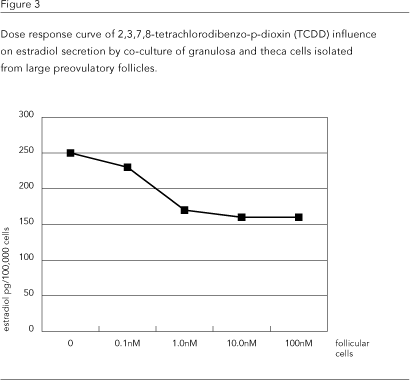
In order to show dose-dependent TCDD action on estradiol secretion, doses of 0.1nM, 1.0nM, 10nM, and 100nM TCDD were added to the culture media. Cells were cultured for 48 hours, and then media were collected for estradiol estimation by radioimmunoassay using Spectria RIA kits (Orion, Diagnostica, Finland), supplied by Polatom (OEwierk, Poland).
Effect of TCDD on cholesterol side chain cleavage cytochrome P450scc, 3b-hydroxysteroid dehydrogenase (3b-HSD), and cytochrome P450arom activities in follicular cells
Granulosa and theca cells were plated together into 24 well plates for 18h incubation with M199 supplemented with 5% calf serum. Then, 25-hydroxycholesterol (25-OH) substrate for pregnenolone formation at a dose of 10µg/ml or pregnenolone (P5) substrate for progesterone production at a dose of 10µg/ml was added to the non-TCDD-treated control and TCDD-treated cells. Six hours later, all cultures were terminated and the media were frozen pending further progesterone, testosterone, and estradiol concentration analysis. Results of these experiments are shown in Figure 4.
It was stated that TCDD did not inhibit progesterone secretion by GT cells when the culture was supported by exogenous 25-OH cholesterol (a substrate for pregnenolone formation) and pregnenolone (a substrate for progesterone production).
These results suggest that this inhibition of progesterone is due to reduction in the activity of the mitochondrial enzyme, which converts cholesterol into pregnenolone (cytochrome P450scc) or pregnenolone to progesterone. The hypothesis drawn from this observation is that TCDD acts before pregnenolone formation. Moore et al. (1991) also noted that pregnenolone formation was blocked after treating rats with aminoglutethimide (AMG), the inhibitor of P450scc. Previous studies provided evidence that the reduction in progesterone secretion must be due to the inhibition of mobilization of cholesterol to cytochrome P450scc (DiBartolomeis et al., 1987). Moore et al. (1991) showed that testosterone synthesis was decreased in TCDD-treated rats because pregnenolone production by the testes was inhibited. This inhibition could only be caused by a reduction in the activity of the mitochondrial enzyme, which converts cholesterol into pregnenolone (cytochrome P450scc). A study conducted on female Cynomolgus monkeys given gavage doses of hexachlorobenzene (a highly lipophilic compound) reported decreases in serum P4 during the luteal phase (Foster et al., 1992). This agrees with data from Kleeman et al. (1990) obtained on male rats. They noted that TCDD did not decrease T secretion when steroidogenesis was supported by exogenous pregnenolone; thus, inhibition of T biosynthesis must result from an inhibition of pregnenolone formation. On the other hand, in 25-OH- and P5-supplemented cultures, TCDD decreased testosterone and estradiol secretion, indicating another mechanism involved in TCDD antiestrogenic action.
Effect of TCDD on cytochrome P450arom activity in follicular cells
P450arom activity was measured by conversion of testosterone (10-7M) to estradiol. The net synthesis and secretion of estradiol to the culture medium was used as the indicator of the aromatase activity. Aromatase inhibitor (CGS 16949A; 4,5,6,7,8-tetrahydroimidazo [1,4-alpydrin-5-yl] benzonitrile monohydrochloride) at a dose of 0.1mM was used to confirm the action of TCDD on these enzymes. At the end the culture media were frozen for testosterone and estradiol analysis. Results are shown in Figure 5.
In this experiment we observed TCDD antiestrogenic action on GT co-cultured with testosterone, indicating that as in the case of P450scc, TCDD also disrupted P450arom. We observed that TCDD added to the testosterone-supplemented cultures additionally increased testosterone secretion with a concomitant decrease in estradiol secretion. Moreover, CGS 16949A the inhibitor of P450arom added to TCDD-treated cells improved testosterone secretion to 146.8% of control cultures and additionally decreased estradiol secretion to 12.6% of TCDD-treated cells. This is in accordance with Dasmahapatra et al. (2000), who showed significant changes in P450scc and P450arom mRNA levels in rat granulosa cells under the influence of TCDD.
Effects on luteal cell function
After ovulation, follicular cells turn into luteal cells, which form the corpus luteum. Both granulosa and theca cells are involved in the formation of luteal tissue. The results of our earlier study (Gregoraszczuk, 1983) indicated that cells isolated from the corpus luteum formed in vivo are not identical to granulosa cells luteinized in vitro. Moreover, the corpus luteum is the ovarian compartment with a strictly limited life span. The regular cycle is dependent on the precise regulation of the life span of the corpus luteum. One of the endocrine functions of corpora lutea is the production of progesterone (Figure 6).

Progesterone synthesis is a complex steroidogenic pathway in the ovary. After ovulation, differentiation of follicular cells into luteal cells capable of producing progesterone is accomplished by increased expression of enzymes necessary for the conversion of cholesterol to progesterone, i.e., cholesterol side-chain cleavage cytochrome P450scc and 3b-hydroxysteroid dehydrogenase (3b-HSD), and decreased expression of enzymes that convert progesterone to estrogens, i.e., 17 a-hydroxylase cytochrome P450 and aromatase cytochrome P450 (Figure 7).
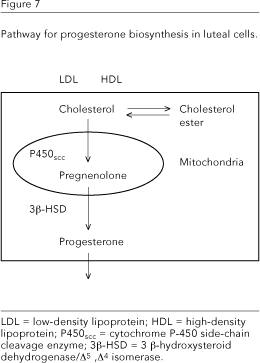
Dose response curve
In order to show the dose response to TCDD in terms of progesterone secretion, luteal cells were cultured at four different doses: 0.1, 1.0, 10.0, and 100nM of TCDD. The cells were cultured for 48h and the media were evaluated for progesterone concentration (Figure 8).

Effect of TCDD on cholesterol side chain cleavage cytochrome P450scc or 3b-hydroxysteroid dehydrogenase (3b-HSD), enzymes involved in progesterone secretion
Cells were plated into 24 well plates for 18h incubation with M199 supplemented with 5% calf serum, after which 25-hydroxycholesterol (25-OH), substrate for pregnenolone formation at a dose 10µg/ml, or pregnenolone (P5), substrate for progesterone production at 10µg/ml, was added to the non-TCDD-treated control and TCDD-treated cells. Six hours later, all cultures were terminated and the media were frozen until further progesterone analysis. Results are shown in Figure 9.
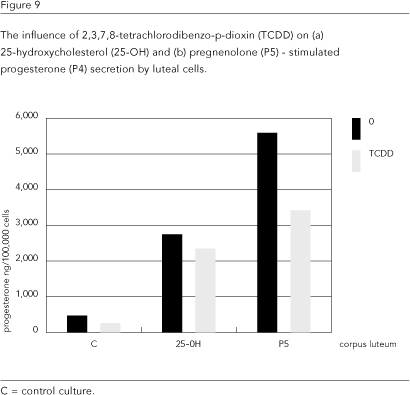
This study demonstrated that the exposure of luteal cells to 3.2ng/ml of TCDD in vitro caused a significant reduction of basal, 25-OH-stimulated, and pregnenolone (P5)-stimulated progesterone secretion by luteal cells.
It also provided evidence that at least one of the effects of TCDD in reducing progesterone secretion was very likely through a direct action on the activity of the enzymes, which convert cholesterol to pregnenolone and pregnenolone to progesterone. Luteal cytochrome P450scc activity (assayed with 25-OH as a substrate) was decreased to 50% of control progesterone, while 3b-HSD activity (assayed with P5 as a substrate) was decreased to 70% of control progesterone. It provides evidence that the key lesion occurs prior to or during pregnenolone formation. Inhibition of histochemically tested activity of 3b-HSD was shown in our previous paper (Gregoraszczuk et al., 1999).
The involvement of aryl hydrocarbon receptor (AhR) and estradiol receptor (ER) in TCDD action on follicular and luteal cells
The best characterized mechanism for the action of TCDD involves the cloned AhR (Burbach et al., 1992), a cytosolic receptor that binds TCDD and other halogenated aryl hydrocarbons. The complex heterodimerizes with the aryl hydrocarbon nuclear translocator (ARNT) and is translocated to the nucleus where it binds to several discrete DNA domains containing dioxin-responsive elements (DRE) (Carrier et al., 1994). The complex acts as a transcription factor to regulate the expression of genes such as CYP1A1, CYP1A2, and CYP1B1, which play important roles in estrogen metabolism (Zhu & Conney, 1998). Some authors suggest that AhR is not an essential regulator of the reproductive function (Schmidt et al., 1996), while others report that AhR may play a role in fertility and fecundity (Nerbert et al., 1984). Studies using AhR blockers are currently being conducted to examine the potential involvement of the AhR in TCDD action. Enan et al. (1996) showed that the reduction of glucose uptake by human luteinizing granulosa cells is mediated through AhR. Such an effect of TCDD was antagonized by the AhR blocker, a- naphthoflavone (ANF).
The presence of a functional AhR capable of binding DNA in the rat ovary and in primate ovarian tissue, including human granulosa cells, was shown by Chaffin et al. (1996, 1997). Safe (1998) showed that toxic and biochemical effects associated with exposure to TCDD are mediated via its initial binding to the cytosol aryl hydrocarbon (Ah) receptor protein present in target tissues and organs. Levels of AhR appear to be the lowest in early CL, and increase in the mid- and late luteal phase tissues. Studies using the AhR blocker a- naphthoflavone are currently being conducted to examine the potential involvement of the AhR in TCDD action (Gasiewicz & Ahon, 1992).
Caruso et al. (1999) investigated the 90kDa-heat shock protein (HSP90) as a mediator of cross-talk between the AhR and the ER signal transduction pathways in human breast cancer cells and demonstrated that Ah-responsiveness is dependent on cellular ER content.
Some authors suggest that the TCDD receptor may be related to the estrogen receptor and that the antiestrogenic action of TCDD is probably independent of the Ah locus (Gallo et al., 1986). Tian et al. (1998) showed that TCDD suppresses the gene expression of the ER receptor by decreasing its transcription and that the AhR plays an important role in mediating this response. Kharat & Saatcioglu (1996) hypothesized that activated AhR competes with ER for some limiting transcription factor(s). On the other hand, DeVito et al. (1992) demonstrated that TCDD does not bind competitively to the E2 receptor, nor does E2 compete for the AhR.
Taking into consideration data by Umbreit & Gallo (1988) suggesting that TCDD's effects on reproductive functions may occur via modulating estradiol and/or ER depending on the species, tissue and hormonal status of an animal, 4-0H-tamoxifen (TMX), a synthetic ER antagonist that inhibits transcription of target gene binding to ER was used to focus on the effect of TCDD on ER.
Co-culture of granulosa and theca cells isolated from large preovulatory follicles and luteal cells were cultured in M199 medium supplemented with 5% calf serum as a control medium or with the addition of either TCDD (3.2ng/ml), a- naphthoflavone, the AhR inhibitor (10mM or TCDD + AhR-Inh), or 4-0H-tamoxifen (4-OH-TMX), the inhibitor of ER (10-7M). Results for estradiol and progesterone secretion are shown in Figures 10 and 11.
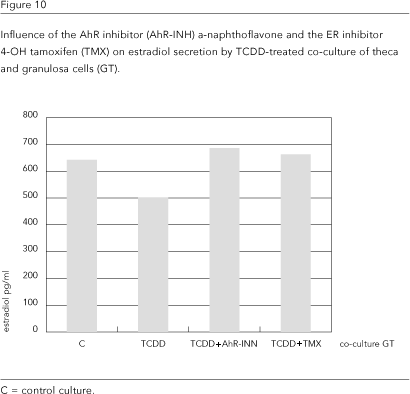

These results demonstrate that the exposure of follicular cells to both the AhR blocker a- naphthoflavone and the ER blocker 4-OH-tamoxifen reversed the inhibitory effect of TCDD on estradiol secretion, indicating possible involvement of a AhR- and ER-mediated mechanism in this process. However, exposure of luteal cells to the AhR blocker a- naphthoflavone reversed the inhibitory effect of TCDD on progesterone secretion, while 4-OH-tamoxifen did not reverse the effect of TCDD, indicating the involvement of a AhR-mediated mechanism and non-ER-dependent signaling in TCDD action on luteal cells. This was probably due to low expression of ER in luteal cells.
Conclusions
In the follicles, TCDD decreases estradiol secretion by follicular cells in a dose-dependent manner by altering conversion of cholesterol to pregnenolone and testosterone to estradiol. Development and maturation of the oocyte occurs within ovarian follicles, therefore TCDD interfering with estradiol production in follicles can affect oocyte development and ovulation.
In the corpus luteum, TCDD decreases progesterone secretion in a dose-dependent manner by the reduction in the activity of mitochondrial enzymes, which convert cholesterol into pregnenolone. Therefore, by interfering with progesterone production it can act as an abortifacient.
We suggest that there is cross-talk between the AhR and the ER signal transduction pathways in porcine follicular cells. In luteal cells, TCDD activity appears to be mediated via binding to the Ah receptors, probably independent of the ER locus.
References
BURBACH, K. M.; POLAND, A. & BRADFIELD, C. A., 1992. Cloning of the Ah-receptor cDNA reveals a distinctive ligand activated transcription factor. Proceedings of the National Academy of Sciences of the USA, 89:8185-8189.
CARRIER, F.; CHANG, C. Y.; DUCH, J. L.; NEBERT, D. W. & PUGA, A., 1994. Interaction of the regulatory domains of the murine Cyp1a1 gene with two DNA-binding proteins in addition to the Ah receptor and the Ah receptor nuclear translocator (ARNT). Biochemical Pharmacology, 48:1767-1778.
CARUSO, J. A.; LAIRD, D. W. & BATIST, G., 1999. Role of HSP90 in mediating cross-talk between the estrogen receptor and the Ah receptor signal transduction pathways. Biochemical Pharmacology, 58:1395-1403.
CHAFFIN, C. L. & HUTZ, R. J., 1997. Regulation of the aromatic hydrocarbon receptor (AHR) by in utero and lactational exposure to 2,3,7,8-tetrachlorodibenzo-p-dioxin (TCDD). Journal of Reproduction and Development, 43:47-51.
CHAFFIN, C. L.; PETERSON, R. E. & HUTZ, R. J., 1996. In utero and lactational exposure of female Holtzman rats to 2,3,7,8-tetrachlorodibenzo-p-dioxin: Modulation of the estrogen signal. Biology of Reproduction, 55:62-67.
CLARK, J. R.; BRAZIER, S. G.; WIGINTON, L. M.; STEVENSON, G. R. & TRIBBLE, L. F., 1982. Time of ovarian follicle selection during the porcine estrous cycle. Theriogenology, 18: 697-709.
COLBORN, T.; DUMANSKI, D. & MEYERS, J. P., 1996. Our Stolen Future. New York: Penguin Books.
COLBORN, T.; vom SAAL, F. S. & SOTO, A. M., 1993. Developmental effects of endocrine-disrupting chemicals in wildlife and humans. Environmental Health Perspectives, 101:378-384.
DASMAHAPATRA, A. K.; WIMPEE, B. A. B.; TREWIN, A. L.; WIMPEE, C. H. F.; GHORAI, J. K. & HUTZ, R. J., 2000. Demonstration of 2,3,7,8-tetrachlorodibenzo-p-dioxin attenuation of P450 steroidogenic enzyme mRNAs in rat granulosa cell in vitro by competitive reverse transcriptase-polymerase chain reaction assay. Molecular and Cellular Endocrinology, 164:5-18.
DeVITO, J. M.; THOMAS, T.; UMBREIT, T. H. & GALLO, M. A., 1992. Multi-site regulation of estrogen receptor by 2,3,7,8-tetrachlorodibenzo-p-dioxin. In: Relevance of Animal Studies to the Evaluation of Human Cancer Risk (R. D'Amato, T. J. Slaga, W. H. Farland & C. Henry, ed.), pp. 321-336, New York: Wiley-Liss.
DiBARTOLOMEIS, M. J.; MOOR, R. W.; PETERSON, R. E.; CHRISTIAN, B. J. & JEFCOATE, C. R., 1987. Altered regulation of adrenal steroidogeneses in 2,3,7,9-tetrachlorodibenzo-p-dioxin-treated rats. Biochemical Pharmacology, 36:59-67.
ENAN, E.; MORAN, F.; VANDERWOORT, C. A.; STEWARD, D. R.; OVERSTREET, J. W. & LASLEY, B. L., 1996. 2,3,7,8-terachlorodibenzo-p-dioxin (TCDD) in cultured human luteinized granulosa cells. Toxicology, 10:497-502.
FOSTER, B. C.; McLEISH, J.; WILSON, D. L.; WHITEHOUSE, L. W.; ZAMECNIK, J. & LODGE, B. A., 1992. Biotransformation of tri-substituted methoxyamphetamines by Cunninghamella echinulata. Xenobiotica, 22:1383-1394.
FOXCROFT, G. R. & HUNTER, M. C., 1985. Basic physiology of follicular maturation in the pig. Journal of Reproduction and Fertility. Supplement, 33:1-19.
GALLO, M. A.; HESSE, E. J.; McDONALD, G. J. & UMBREIT, T. H., 1986. Interactive effects of estradiol and 2,3,7,8-tetrachlorodibenzo-p-dioxin on hepatic cytochrome P450 and mouse uterus. Toxicology Letters, 32:123-132.
GASIEWICZ, T. A. & AHON, M. J., 1992. Isomers of phenanthroline as antagonist. In: 31st Annual Meeting of the Society of Toxicology, Abstracts, p. 714. Seattle: Society of Toxicology.
GRAY, E. L.; MONOSSON, E. & KELCE, W. R., 1996. Emerging issues: The effects of endocrine disruptors on endocrine development. In: Interconnections Between Human and Ecosystem (R. T. Giulio & E. Monosson, ed.), pp. 46-58, London: Chapman and Hall.
GRAY Jr., L. E. & OSBTBY, J. S., 1995. In utero 2,3,7,8-tetrachlorodibenzo-p-dioxin (TCDD) alters reproductive morphology and function in female rat offspring. Toxicology and Applied Pharmacology, 133:285-294.
GREGORASZCZUK, E. L., 1983. Steroid hormone release in cultures of pig corpus luteum and granulosa cells. Effect of LH, hCG, PRL and estradiol. Endocrinologia Experimentalis, 17:59-68.
GREGORASZCZUK, E. L.; ZABIELNY, E.; PIEKLO, R.; GROCHOWALSKI, A.; WOJTOWICZ, A. K. & MIKA, M., 1999. Effects of 2,3,7,8-tetrachlorodibenzo-p-dioxin (TCDD) on luteal cell function. Tissue culture approach. Organohalogen Compounds, 42:67-71.
GROCHOWALSKI, A.; PIEKLO, R.; GASINSKA, A.; CHRZASZCZ, R. & GREGORASZCZUK, E. L., 2000. Accumulation of 2,3,7,8-tetrachlorodibenzo-p-dioxin (TCDD) in porcine follicles after in vitro exposure to TCDD: Effects on steroid secretion and cell proliferation. Cytobios, 102:21-31.
HANKINSON, O., 1995. The aryl hydrocarbon receptor complex. Annual Review of Pharmacology and Toxicology, 35:307-340.
JOBLING, S.; REYNOLDS, T.; WHITE, R.; PORTER, M. G. & SUMPTER, J. P., 1995. A variety of environmentally persistent chemicals, including some phthalate plasticizers, are weakly estrogenic. Environmental Health Perspectives, 103:582-587.
JOHNSON, H. T.; KEILE, J. E.; GADDY, R. G.; LOADHOLT, C. B.; HENNIGAR, G. R. & WADER, E. M., 1976. Prolonged investigation of commercial DDT and PCB: Effects on progesterone levels and reproduction in the mature female rat. Archives of Environmental Contamination and Toxicology, 3:479-483.
KHARAT, I. & SAATCIOGLU, F., 1996. Antiestrogenic effects of 2,3,7,8-tetrachlorodibenzo-p-dioxin are mediated by direct transcriptional interference with the liganded estrogen receptor. Journal of Biological Chemistry, 271:10533-10537.
KLEEMAN, J. M.; MOOR, R. W. & PETERSON, R. E., 1990. Inhibition of testicular steroidogenesis in 2,3,7,8-tetrachlorodibenzo-p-dioxin treated rats: Evidence that the key lesion occurs prior to or during pregnenolone formation. Toxicology and Applied Pharmacology, 106:237-248.
McLACHLAN, J. A., 1993. Functional toxicology: A new approach to detect biologically active xenobiotics. Environmental Health Perspectives, 101:386-387.
MOORE, R.W.; JEFCOATE, C. R. & PETERSON, R. E., 1991. 2,3,7,8-tetrachlorodibenzo-p-dioxin inhibits steroidogenesis in the rat testis by inhibiting the mobilization of cholesterol to cytochrome P450scc. Toxicology and Applied Pharmacology, 109:85-97.
MORAN, F. M.; ENAN, E.; VANDERWOORD, C. A.; STEWART, D. R.; CONLAY, A. J; OVERSTREET, J. V. & LASLEY, B. L., 1997. 2,3,7,8-tetrachlorodibenzo-p-dioxin (TCDD) effects on steroidogenesis of human luteinized granulosa cells in vitro. Society for the Study of Reproduction, Abstracts, 65(Sup. 1):56.
NERBERT, D. W.; BROWN, D. D.; TOWNE, D. W. & EISEN, H. J., 1984. Association of fertility, fitness and longevity with the murine Ah locus among (C57BL/HeN) recombinant inbred lines. Biology of Reproduction, 30:363-373.
PIEKLO, R.; GROCHOWALSKI, A. & GREGORASZCZUK, E. L., 2000. 2,3,7,8-tetrachlorodibenzo-p-dioxin alters follicular steroidogenesis in time and cell-specific manner. Experimental and Clinical Endocrinology & Diabetes, 108:299-304.
POLAND, A. & KNUTSON, J. C., 1982. 2,3,7,8-tetrachlorodibenzo-p-dioxin and related halogenated aromatic hydrocarbons: Examination of the mechanism of toxicity. Annual Review of Pharmacology and Toxicology, 22:517-554.
SAFE, S. H., 1998. Development validation and problems with the toxic equivalency factor approach for risk assessment of dioxin and related compounds. Journal of Animal Sciences, 76:134-140.
SAFE, S. H., 1999. 2,3,7,8-tetrachlorodibenzo-p-dioxin (TCDD) and related environmental antiestrogens: Characterization and mechanism of action. In: Endocrine Disruptors (R. K. Naz, ed.), pp. 187-221, Boca Raton/London/New York/Washington, DC: CRC Press.
SCHMIDT, J. V.; SU, G. H. T.; REDDY, J. K.; SIMON, M. C. & BRADFIELD, C. A., 1996. Characterization of a murine AhR null allele: Involvement of the Ah receptor in hepatic growth and development. Proceedings of the National Academy of Sciences of the USA, 93:6731-6736.
STABENFELDT, G. H.; AKINS, E. L.; EWING, L. L. & MORRISSETTE, M. C., 1969. Peripheral plasma progesterone levels in pigs during the oestrus cycle. Journal of Reproduction and Fertility, 20:443-449.
TIAN, Y.; KE, S.; THOMAS, T.; MEEKER, R. J. & GALLO, M. A., 1998. Transcriptional supression of estrogen receptor gene expression by 2,3,7,8-tetrachlorodibenzo-p-dioxin (TCDD). Journal of Steroid Biochemistry and Molecular Biology, 67:17-24.
TOMAS, P. & KHAN, I. A., 1997. Mechanisms of chemical interference with reproductive endocrine function in sciaenid fish. In: Functional Development and Reproduction of Fish (R. M. Rolland, M. Gilbertson & R. E. Peterson, ed.), SETAC Technical Populations Series 29, pp. 29-37, Pensacola: SETAC.
UMBREIT, T. H. & GALLO, M. A., 1988. Physiological implications of estrogen receptor modulation by 2,3,7,8-tetrachlorodibenzo-p-dioxin. Toxicology Letters, 42:5-14.
WHITLOCK, J. P., 1993. Mechanistic aspects of dioxin action. Chemical Research and Toxicology, 6:754-763.
ZHU, B. T. & CONNEY, A. H., 1998. Functional role of estrogen metabolism in targeted cells: Review and perspectives. Carcinogenesis, 19:1-27.
Submitted on 5 February 2001
Final version resubmitted on 2 May 2001
Approved on 6 July 2001
